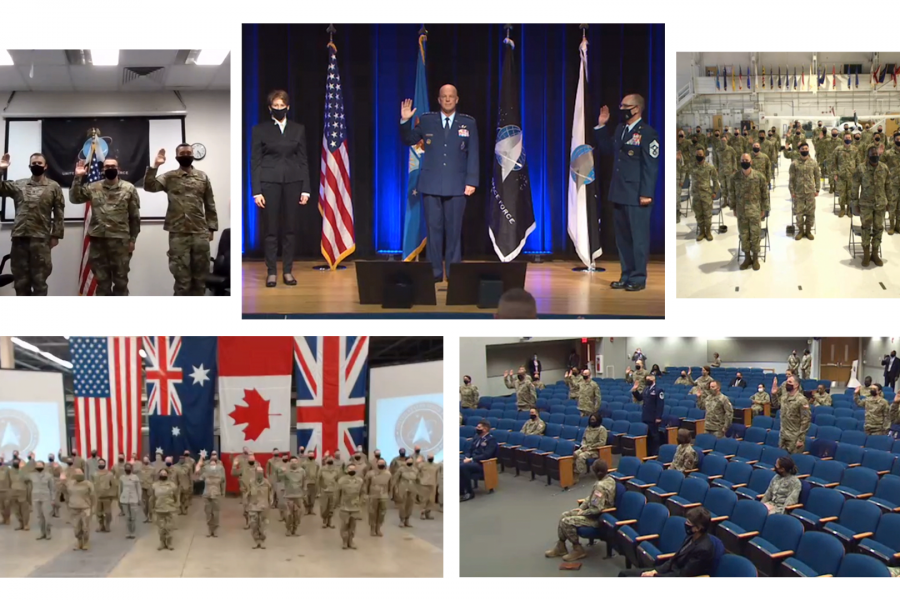When the Space Force’s first seven enlisted recruits head to Basic Military Training next month, they will become the guinea pigs in one of many experiments underway in the new service aimed at building a better armed force.
The service is embarking on a series of what Chief Master Sgt. Roger A. Towberman, the service’s senior enlisted adviser, calls “small-batch solutions.” Those allow the Space Force to float trial balloons on issues from workout uniforms to training in focus groups of a few dozen people, without quickly committing to one solution.
“We don’t have to come up with a final answer that’s going to apply to the full force for what we think is the next 10 years,” he told Air Force Magazine on Sept. 11. “We can say, hey, let’s do something that applies to a small group, and try it out and see what it looks like. Then if we like it, we’ll scale it.”
That concept applies to Joint Base San Antonio, Texas, which will host the Space Force’s first BMT class in October. Their experiences will help the service find the sweet spot for how large its boot camp classes should be.
“Why do we have to choose? Maybe we do six at a time, and then … one time next spring, we’ll do a class of 30 and we see how that works,” Towberman said. “It really is an ecosystem and everything’s connected to everything else. I can change something so that basic training works better, and it may make technical training work worse, or it may put the recruiters in a position where they’ve got to make compromises in order to meet the numbers that they need to keep us on track.”
The branch could settle on anything from running BMT classes with about seven students a week, to around 300 people in one large cohort per year. Officials may find that smaller classes don’t bond as well as a bigger force, or that giant groups create too much pressure later in the pipeline.
Training officials are mulling what tech school could look like as well, and whether the Space Force could use the same instructors for both BMT and technical training.
“These 10 people can have these three instructors, or whatever it is, and just try it,” Towberman said. “Do we have to do basic training separately from anything? Could we do basic training as part of tech school and it’s just called training and you just show up and you do it all together in one location?”
Space Force headquarters also wants to give its local commanders more free rein over their own work. If something is a good fit at Peterson Air Force Base, Colo., but not Patrick Air Force Base, Fla., both installations shouldn’t be held to the same standardized process, Towberman suggested.
He thinks the approach will woo younger Airmen who might feel stifled by typical military bureaucracy.
“I think all we really have to do is sincerely say, we trust you, we got your back,” Towberman said. “It’s safe to fail, go. Do whatever you want. Let’s watch it and pay attention, and here’s the safety net.”
For now, there are certain ideas the Space Force wants to apply to all members.
As the service adds “space flavor” to military education, that means more than simply teaching people about space operations, Towberman argues. The training pipeline is also a chance to instill a Space Force culture that stands apart from the other services.
“If we decide that we want to work more on interpersonal communication skills, we might change interpersonal communication in [professional military education],” Towberman said. “That wouldn’t be a space thing, right? It would be a Space Force thing.”
The service is pushing digital literacy in its ranks, too. The Space Force is issuing 6,000 spots in the Department of the Air Force’s Digital University, which offers an online course catalog with IT and cybersecurity training and computer science languages, Chief of Space Operations Gen. John W. “Jay” Raymond said Sept. 15 at AFA’s virtual Air, Space & Cyber Conference.
About 120 students have graduated so far from new courses in orbital warfare, electronic warfare, and space battle management, Raymond added.
Once Airmen—or whatever their formal name will be in the future—graduate, they can access a growing pool of professional opportunities. In addition to jobs within typical Space Force units, budding international partnerships in space promise more chances to work alongside military personnel from countries like Canada, France, or Japan. Those career choices can also evolve as the Space Force bolsters its deployments to U.S. installations around the world.
“I don’t think those opportunities will look necessarily like other services,” Towberman said in a Sept. 15 speech during the conference. “I don’t think we’re going to build a base in Germany, for instance, anytime soon. But I think that the individual opportunities are going to exist because we have to have great allies and partners to pull this off.”
Space Force members are already working as legislative liaisons on Capitol Hill, a key post as the service looks to secure its fiscal 2021 and 2022 budgets in the coming year.
“We’re going to have folks in positions where we can make a difference and we can have a perspective,” Towberman said. “Diversity always includes many, many things. One of the things that includes is we need an enlisted perspective, so we’re going to do everything we can to do that.”
